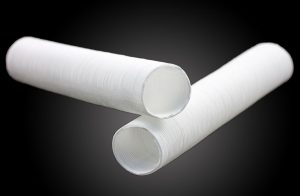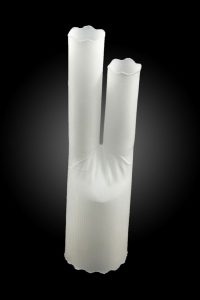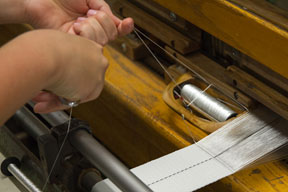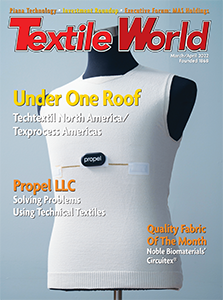
为医疗设备纺织品选择理想的纤维和编织
阿米尔伊斯兰教
一种S医疗技术增加了,用于不同生物医学应用的期权的可用性也是如此。在编织生物医学纺织品中可用的许多不同特征中,选择正确的可靠纺织品对于降低风险和确保成功的程序和应用至关重要。
Woven Biotextile Properties
编织生物医学纺织结构,例如直,锥形,喇叭形和分叉的血管移植物,是一门需要精确和坚定不移的细节关注的艺术。结构是通过编织,编织和编织制成的,其中两组纤维或纱线被紧密交织。生物医学应用的高质量编织纺织结构具有尺寸稳定性,高缝合力保留强度,高爆发强度以及受控的渗透率和孔隙率。此外,它们在两个方向上都体现了高抗拉强度。低伸长率,与编织产品不同;以及高磨损和抗摩擦力。
Many of these biomedical textile structure characteristics are prerequisites for use in implanted applications. Without high abrasion and friction resistance, for example, wear from internal movement could lead to malfunction and failure. Other characteristics particularly benefit specific applications, such as high burst strength for vascular implants required to hold up to blood pressure. Dimensional stability enables structures to retain their shapes for longer periods of time, and low elongation in a woven structure ensures the device serves its intended purpose. High tensile strength in both directions protects devices against defects from wear. Controlled permeability and porosity are especially important in a biotextile because it can withstand consistent blood flow. Finally, high suture retention strength enables the device to remain properly in place during implantation and recovery.
生物布局的优势证明在减轻风险中很重要,因此许多设备设计师选择生物织物而不是用于生物医学应用的非纺织品选项。例如,例如弹性体管等材料没有相同的有益特征。

选择合适的生物医学纤维
近年来,医疗技术已经大大发展。With so many material options available, appropriately selecting a biomedical fiber for a given application depends on the performance required of the biomedical device in question.
例如,由于与人体具有生物相容性,PET(聚酯)纤维已在可植入的设备中使用了很多年。相反,PGA(聚乙醇酸)纤维不用于持久的可植入器件,因为该纤维旨在随着时间的推移溶解。作为另一个例子,使用“内存”的金属丝(金属线)用于需要电线恢复其原始形状的应用。有时,该线与聚酯纤维结合使用。
Fibers are either absorbable or non-absorbable, an important distinction for almost any application. Non-absorbable fibers include polyethylene terephthalate (PET), expanded PET (ePET), polypropylene, high-modulus polyethylene fibers (Spectra®, Dyneema®), polytetrafluoroethylene (PTFE), expanded PTFE, polyurethane, and metallic wires. Absorbable fibers include polyglycolic acid (PGA), polylactic acid (PLA), and polylactic glycolic acid (PLGA). Hybrid fibers are made when non-absorbable and absorbable fibers are woven together. With decades of experience in biotextile weaving, Bally Ribbon Mills has the capability to use monofilament, multifilaments, hybrid fibers, and metallic wires in their products.
在选择适当的生物医学纤维时,要考虑到适当的生物医学纤维时,也要考虑与特定医疗设备相关的风险,以便尽可能减轻风险。FDA通过对患者和/或用户的风险以及设备的预期使用来将医疗设备分为I类,II类和III类。那些被归类为III级的高风险的人通常会植入或支持寿命,或者出现潜在的疾病或伤害的不合理风险。例子包括可植入的速度制造商,阴茎移植物,支架和血管移植物。考虑到相关人员的高风险,使用最适合该应用的纤维至关重要。
With so many material options available, appropriately selecting a biomedical fiber for a given application depends on the performance required of the biomedical device in question.
 穿梭织机优势
穿梭织机优势
使用生物织物设计和原型是一个需要先进技术的复杂过程。这个过程需要对纺织纤维,纺织机械和编织设计的广泛专业知识,技能和知识。
有梭织机技术可以产生完美的管子,bifurcated tubes, flared tubes, and tapered tubes as well as desired shapes. Other weaving technologies, such as needle looms and rapier looms, cannot produce a perfect tube or other required shapes without fringes or double picks. Medical devices should not have any defects, such as missing picks, floats, or broken ends, that could affect performance. In addition, the dimensions of the device should be perfectly precise. Only automated shuttle looms can eliminate these defects. For these reasons, Bally Ribbon Mills exclusively uses shuttle loom technology to weave biomedical textiles in order to ensure the highest quality products.
在Bally Ribbon Mills,所有医疗产品均在8级认证的清洁室中制造,包括航天飞机织机编织的所有方面。由于与此类设备相关的风险,所有III级医疗设备都必须在紧密控制的清洁室环境中制造。该公司的质量控制专业人员还监视操作,并在清洁室内进行最终检查。借助这种制造环境和严格的质量控制过程,BRM是ISO 13485经过认证,可为医疗设备设计和制造纺织品组件。
The Future of Biotextiles
The future of weaving for biomedical applications is trending toward increasingly advanced shuttle loom technology with more automated features. New advancements include the incorporation of electronic components and jacquard capabilities (a system of weaving that utilizes a highly versatile pattern mechanism, enabling the production of large, intricate designs and shapes). Looking to the future, Bally Ribbon Mills recently updated its biomedical weaving capabilities with an automated shuttle loom with multiple shuttles. Increasing automation will produce the highest quality of biotextiles, ensuring biomedical application needs are met with the most cutting-edge materials for years to come.
Editor’s Note: Amir Islam is director of research and development, Bally Ribbon Mills, Bally, Pa.
2019年12月





